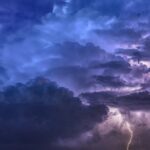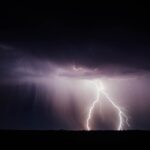In summer, you’re likely to observe lightning if you’re on an extended hike. While odds of being struck randomly by lightning are very low, bald summits and open ridgelines along the A.T. can be extremely dangerous in a lightning storm. At least four people are known to have died on the A.T. from lightning. Many more have been struck and suffered severe, sometimes permanent, injuries.
Your best protection is to monitor weather forecasts and avoid being outside when thunderstorms are forecast. If you’re on a long hike, plan your hike to avoid times and areas of most risk and be prepared to adapt.
Most Importantly: Plan Ahead
Check weather and avoid hazardous locations. Monitoring forecasts and avoiding the most lightning-prone areas for storms are key.
Having a NOAA weather radio is ideal; weather websites and apps can give you forecasts ahead of time and send you alerts for thunderstorms. The site www.atweather.org provides forecasts for shelters along the A.T.
If you’re on the Trail when a storm is imminent and you hear thunder, see lightning, or if skies look threatening, you need to get away from the most dangerous places and seek places with lower risk.

Key points to reduce your risk
- Immediately move away from open areas, summits and ridgelines. Lightning is attracted to high points. Balds (treeless summits that occur below the treeline) such as those found along the A.T. in North Carolina, Tennessee, and Virginia can be especially dangerous. Fatalities have occurred on Max Patch in North Carolina and Cold Mountain in Virginia. Summits and ridgelines above the treeline in New England are also especially dangerous; fatalities have occurred on Franconia Ridge and on Katahdin. But any place is hazardous where you become the tallest feature in the surrounding area such as cliff edges, rocky overhangs and observation platforms.
- Run for cover – the cover of a forest. Unless you happen to be near your car (with a metal roof) or have access to a substantial, enclosed modern building, the lower slopes of a forest are the safest place. Position yourself the maximum distance away from tree trunks. Avoid caves, which are dangerous.
- Avoid any tall features that stand out from the surroundings, such as isolated trees and tall structures. Communication towers, monuments and bear poles are features you might need to avoid on the A.T.
- Move away from water, including the Trail itself if a downpour has turned it into a stream. Move away from ponds, lakes, and streams; avoid puddles. Water does not need to be deep to conduct electricity.
- Drop metal objects such as backpacks with metal frames (internal and external) and trekking poles. It’s less important to get rid of jewelry or clothing with zippers or other metal fixtures or features, as they aren’t likely to attract lightning, but if time allows after you have found relative safety, remove these items as they could burn you if you are struck.
- Spread out your group, 100 feet apart, to reduce the chance that you’ll have more than one victim if lightning does strike.
Stay away from ropes, cords, powerlines, metal fences and other long metallic objects – these can concentrate currents. A cell phone will not put you at risk but charging it will. - Crouch on the ground with your weight on the balls of the feet, your feet together, your head lowered, ears covered. Do not lie flat on the ground; avoid rocks.
- Be aware that Trail shelters will not protect you from lightning. Multiple people have been struck by lightning at the Vandeventer Shelter in Tennessee, which is situated on a ridgetop near the edge of a cliff. In a heavy rainstorm with strong winds when falling limbs and trees are a threat, shelters surrounded by trees of relatively uniform height may be the best option when you are far from civilization. If you decide on a shelter, stay away from the open side and any windows.
- Wait 30 minutes after you hear the last clap of thunder in a reduced-risk area. Lightning can strike well after the storm has appeared to have passed.
- Avoid pitching your tent under the tallest tree as storms can develop during the night.
- Be prepared to call 911 or deploy a satellite messenger, give CPR with rescue breathing, and treat for shock.



